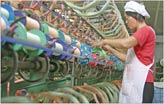Economy
Experts warn of subsidence threat along new railway
Updated: 2011-06-16 10:21
By Xin Dingding and Xu Wei (China Daily)
Extracting underground water poses danger to line's stability
BEIJING - Railway experts have called on local governments along the Beijing-Shanghai high-speed rail line to stop jeopardizing the landmark project by drawing underground water.
Subsidence of the foundation of the Beijing-Shanghai high-speed railway must be kept within 5 millimeters in 100 years, if trains run at 380 km/h on the 1,318-km-long line.
The remarks coincide with the news that the $17.6-billion high-speed railway linking Taipei and Kaohsiung has a section between Yunlin and Changhua facing problems of ground subsidence and may have to be closed in 10 years should the problem remain unsolved. The railway was put into service in 2007.
Lee Hong-yuan, an official in charge of the public construction commission in Taiwan, told Xinhua News Agency on Tuesday that investigations indicated the ground at both Yunlin and Changhua was sinking at a pace of 7 to 8 centimeters a year. Analysts said that excessive extraction of underground water was the main cause of the ground sinking in both cities.
Guo Zhiyong, senior engineer with the Fourth Survey and Design Group Co Ltd under China Railway Construction Corporation Limited, said on Wednesday that the southern part of the Beijing-Shanghai high-speed railway also faces such threats.
Shanghai had a long-standing problem of ground subsidence caused by underground water extraction. The problem aroused public concerns in 2007, when the city's ground subsided 7.5 cm on average, according to a report by Xinhua.
Not only Shanghai, but also the whole Yangtze River Delta is among the areas in China most affected by ground subsidence. Experts said that over-extraction of underground water and improper urban construction caused the problem.
"If not well controlled, these cities will subside," Guo said. "The Beijing-Shanghai high-speed railway project just underlined its importance again."
The Ministry of Railways and the provinces along the line had issued circulations during the project banning underground water extraction in a certain range on both sides of the Beijing-Shanghai high-speed railway, he said.
According to media reports, Shanghai has restricted annual underground water extraction from 20 million cubic meters in 1965 to less than 8 million cu m and replaces water underground every winter. Jiangsu province also closed thousands of wells in areas suffering subsidence.
"It should be made into law to make sure the ban is enforced," Guo added.
Complicated geological conditions in that area could also cause unwanted land subsidence, Guo said.
For example, some areas between Xuzhou and Shanghai have karst caves; an earthquake rupture belt exists in the section between Bengbu and Chuzhou in Anhui province; and the land in Changzhou, Jiangsu province, and in Shanghai is as soft as tofu because it was formed by silt that piled up from the sea over centuries.
Some experts said the ministry should wait an additional few years to let the lines to achieve natural subsidence before being put into service. Once a high-speed railway is operating, unwanted subsidence of its foundation could lead to slower speeds, uncomfortable travel experiences or even derailment accidents.
Guo said measures taken in the Yangtze River Delta include laying rail tracks on bridges with long foundation piles that reach deep into the land. "Most of these foundation piles built on soft land could reach 50 meters into the ground, some even to 100 meters," he said.
A source with China Railway Construction Group Co Ltd told Beijing Evening News on Wednesday that in many sections of the rail line, construction companies developed methods to compress the concrete infrastructure for months, which has an effect equivalent to three to five years' natural foundation subsidence.
Wu said that the shortage of rail transport capacity in China meant that the country could not afford to lose any time in building high-speed lines, but the measures taken could effectively control subsidence.
Per capita railway mileage in China is only 6 cm, shorter than a cigarette, Xinhua reported earlier.
Specials

When two are one
After a separation of 360 years, Huang Gongwang's famous Dwelling in the Fuchun Mountains has been made whole again.

Wealth of difference
Rich coastal areas offer contrasting ways of dealing with country's development

Seal of approval
The dying tradition of seal engraving has now become a UNIVERSITY major



